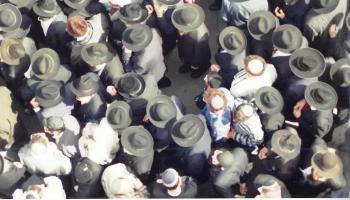When the Wind Blows, The Kippah Will Fall
Washington Heights, where I teach regularly, is an extremely windy location. My bobby pin is greatly challenged holding my yarmulke onto my, fairly short, hair. Holding my yarmulke on, picking it up and chasing it down Amsterdam Avenue, has made me think about it a little more. The word yarmulke, is made up of two Aramaic words, “yarei” and “malka,” which mean “fear of the King.” This name expresses one purpose of the head covering, which is to remind us that we are always in God’s presence. It is worn constantly to encourage a feeling of awe that this awareness should bring. As early as Talmudic times, the Sages advised a mother to cover her son’s head so that he would know that the power of God is above him at all times. Today, it is customary to educate boys to wear yarmulkes even when they are very young, most commonly from age three.
The Sages also associated covering the head with the characteristic of humility, related perhaps to the fact that in ancient times, slaves would wear a head covering. The practice of men covering their heads became so widespread that by the 17th century it was recorded in the Code of Jewish Law. Later in history, it became customary for Gentiles to uncover their heads when praying or entering a church. Since the Torah prohibits imitating the customs of other religions, Jews are obligated specifically to cover their heads during prayer.
No particular requirements regulate the color, material or size of the head-covering. Multi-colored crocheted kippot, black felt yarmulkes, baseball caps and black fedoras are all acceptable. It is interesting to note, however, that today the different types of head-coverings usually identify a wearer’s affiliation within Judaism. Some people always wear a hat anytime they go outside, as well as for prayer. Others have specific head-coverings that are used for special occasions. Members of many Chassidic groups, for example, wear shtreimlach or spodeks, fur hats similar to those that were once worn by the nobility in Eastern Europe. They wear these on Shabbat and festivals, to show that at these times, every Jew becomes like royalty.
The standard kippah of religious Zionists is white or colored and intricately crocheted, while a typical American yeshivah student might wear a black velvet or leather yarmulka. Certainly, the style of yarmulka that someone wears should never determine how we evaluate that person; it is merely one way in which individuals identify themselves with a particular group or ideology to which they feel an affinity.
Since wearing of a head covering at all times is a custom (albeit very widespread) and not a legal requirement, Jewish law allows one to remove the head covering in situations where wearing it would jeopardize one’s livelihood. The exception may be made, for example, for lawyers appearing in court, or people doing business in a place where observant Jews are a rarity. Most men, however, will wear a head covering at all times (except, of course, when bathing, swimming and sleeping). When studying Torah, praying or saying a blessing, wearing a head covering is obligatory.
A further insight into the significance of covering one’s head or hair emerges when one examines the contrast between statues of the Greek philosophers who were almost always portrayed bareheaded, whereas the attitude of the Talmudic Sages, was that they were, in the words of Maimonides, “repelled by an uncovered head.” This distinction reflects two profoundly divergent philosophies. The Greeks believed that their minds were the ultimate judges of reality and morality, that there is no cap or limitation on the human brain. The Jewish view accepts that our perception is limited, that human beings are not the ultimate arbiters of moral standards — that these must come from an absolute source, God. We cover our heads to demonstrate our understanding that the human mind is limited, that an Authority exists above and beyond us.

